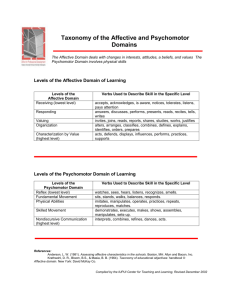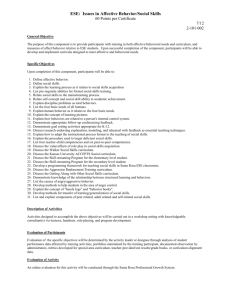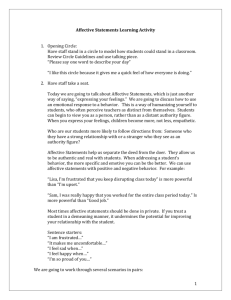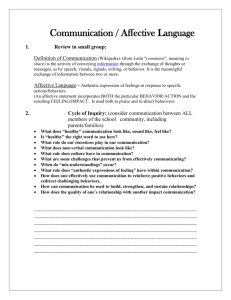Visualizing the Affective Structure of a Text Document
advertisement
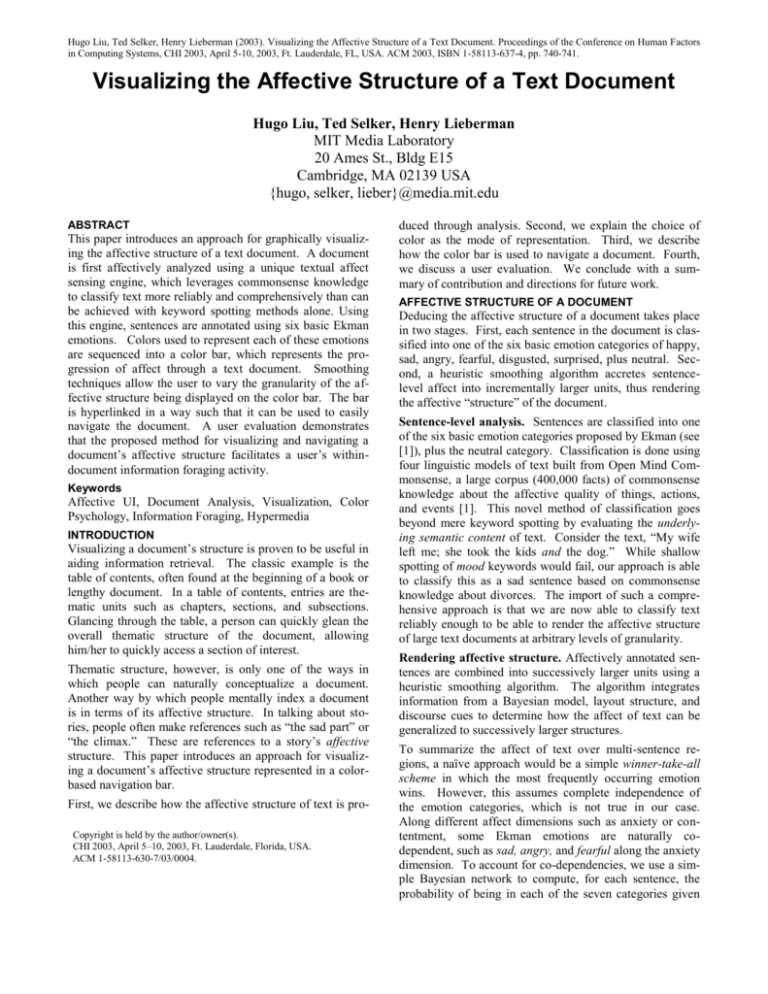
Hugo Liu, Ted Selker, Henry Lieberman (2003). Visualizing the Affective Structure of a Text Document. Proceedings of the Conference on Human Factors
in Computing Systems, CHI 2003, April 5-10, 2003, Ft. Lauderdale, FL, USA. ACM 2003, ISBN 1-58113-637-4, pp. 740-741.
Visualizing the Affective Structure of a Text Document
Hugo Liu, Ted Selker, Henry Lieberman
MIT Media Laboratory
20 Ames St., Bldg E15
Cambridge, MA 02139 USA
{hugo, selker, lieber}@media.mit.edu
ABSTRACT
This paper introduces an approach for graphically visualizing the affective structure of a text document. A document
is first affectively analyzed using a unique textual affect
sensing engine, which leverages commonsense knowledge
to classify text more reliably and comprehensively than can
be achieved with keyword spotting methods alone. Using
this engine, sentences are annotated using six basic Ekman
emotions. Colors used to represent each of these emotions
are sequenced into a color bar, which represents the progression of affect through a text document. Smoothing
techniques allow the user to vary the granularity of the affective structure being displayed on the color bar. The bar
is hyperlinked in a way such that it can be used to easily
navigate the document. A user evaluation demonstrates
that the proposed method for visualizing and navigating a
document’s affective structure facilitates a user’s withindocument information foraging activity.
Keywords
Affective UI, Document Analysis, Visualization, Color
Psychology, Information Foraging, Hypermedia
INTRODUCTION
Visualizing a document’s structure is proven to be useful in
aiding information retrieval. The classic example is the
table of contents, often found at the beginning of a book or
lengthy document. In a table of contents, entries are thematic units such as chapters, sections, and subsections.
Glancing through the table, a person can quickly glean the
overall thematic structure of the document, allowing
him/her to quickly access a section of interest.
Thematic structure, however, is only one of the ways in
which people can naturally conceptualize a document.
Another way by which people mentally index a document
is in terms of its affective structure. In talking about stories, people often make references such as “the sad part” or
“the climax.” These are references to a story’s affective
structure. This paper introduces an approach for visualizing a document’s affective structure represented in a colorbased navigation bar.
First, we describe how the affective structure of text is proCopyright is held by the author/owner(s).
CHI 2003, April 5–10, 2003, Ft. Lauderdale, Florida, USA.
ACM 1-58113-630-7/03/0004.
duced through analysis. Second, we explain the choice of
color as the mode of representation. Third, we describe
how the color bar is used to navigate a document. Fourth,
we discuss a user evaluation. We conclude with a summary of contribution and directions for future work.
AFFECTIVE STRUCTURE OF A DOCUMENT
Deducing the affective structure of a document takes place
in two stages. First, each sentence in the document is classified into one of the six basic emotion categories of happy,
sad, angry, fearful, disgusted, surprised, plus neutral. Second, a heuristic smoothing algorithm accretes sentencelevel affect into incrementally larger units, thus rendering
the affective “structure” of the document.
Sentence-level analysis. Sentences are classified into one
of the six basic emotion categories proposed by Ekman (see
[1]), plus the neutral category. Classification is done using
four linguistic models of text built from Open Mind Commonsense, a large corpus (400,000 facts) of commonsense
knowledge about the affective quality of things, actions,
and events [1]. This novel method of classification goes
beyond mere keyword spotting by evaluating the underlying semantic content of text. Consider the text, “My wife
left me; she took the kids and the dog.” While shallow
spotting of mood keywords would fail, our approach is able
to classify this as a sad sentence based on commonsense
knowledge about divorces. The import of such a comprehensive approach is that we are now able to classify text
reliably enough to be able to render the affective structure
of large text documents at arbitrary levels of granularity.
Rendering affective structure. Affectively annotated sentences are combined into successively larger units using a
heuristic smoothing algorithm. The algorithm integrates
information from a Bayesian model, layout structure, and
discourse cues to determine how the affect of text can be
generalized to successively larger structures.
To summarize the affect of text over multi-sentence regions, a naïve approach would be a simple winner-take-all
scheme in which the most frequently occurring emotion
wins. However, this assumes complete independence of
the emotion categories, which is not true in our case.
Along different affect dimensions such as anxiety or contentment, some Ekman emotions are naturally codependent, such as sad, angry, and fearful along the anxiety
dimension. To account for co-dependencies, we use a simple Bayesian network to compute, for each sentence, the
probability of being in each of the seven categories given
Figure 1. The affect color bar in the top frame, document in the bottom frame.
the annotation of the current sentence. The network was
learned from an annotated training corpus of 510 sentences
across 15 documents, over various sub-genres of story text.
Summing the probability of being in each category over all
the sentences in a text region, we were able to achieve a
better smoothing model than the naïve voting method.
In order to determine boundaries for regions over which
affect is summarized, we consider layout structure and discourse cues. Layout structure prefers that affective structure boundaries correspond with layout breaks, such as paragraph, scene, or chapter breaks. Discourse cues are keywords and phrases which saliently denote a shift of discourse, such as sentences beginning with “all of a sudden,”
or “surprisingly.” These cues provide more fine-grained
clues about affective structure boundaries, and are used in
conjunction with layout structure to partition text.
VISUALIZING AFFECT USING COLORS
Our motivation to represent affect using color is two-fold.
First, colors have an inherent affectively evocative nature.
Using [2] as a guideline, we chose one particular affect-tocolor correspondence scheme. Since no color encoding can
claim to be completely intuitive, there is a learn-it component to this scheme. Also, since the emotional connotation
of color has a cultural component (for example, white represents death in some asian cultures), it may be desirable in
the future to develop culturally sensitive schemes.
A second motivation for representing affective structure
using color is that colors are visually distinct, can codify a
large number of categories, and are identifiable even in
small slices. Consider the alternatives. A graph plot visualization would require a different contour curve to represent each emotion. Regions annotated with labels or patterns would not be identifiable if occurring in small slices.
NAVIGATING A DOCUMENT USING THE COLOR BAR
The affect color bar (Figure 1) displays in a frame above
the text document being visualized. The x-axis position of
the bar corresponds to the y-axis position of the document.
The granularity of affect analysis can be varied using the
zoom controls to the right of the bar. Mousing over any
part of the bar will pop-up a small tooltip whose background is of the same color. An emoticon corresponding to
the emotion depicted by that color is included to help reinforce the meaning of that color. A text caption indicates
the chapter name / section title of the story region being
moused over. The bar is hyperlinked such that clicking an
x-position on the bar scrolls the document in the bottom
frame to the corresponding y-position. Optionally, the
document text can be colored to match the colors in the bar.
EVALUATION
We presented four users with four story documents (e.g.
news article, novel) each, two that each user characterized
as familiar, and two unfamiliar. For each document, users
were asked to perform two timed information access tasks
(e.g. navigate to where the wolf eats the grandmother). In
all cases, users were asked to access an important event in
the story. The first task was performed with the affect bar,
and the second task, with a layout identical to the affect bar
except that the color is uniformly yellow and no emoticon
is shown in its tooltip (control). The results of this initial
study showed that the affect bar improved the speed of the
task by an average of 27% for familiar story documents and
36% for unfamiliar story documents. Improvement was not
as dramatic for familiar stories, where users more frequently relied on their knowledge of the order of events in navigation. Also, users sometimes reverted to browsing by
thematic events when there was confusion about the meaning of the colors. A longer-term study in which participants have more fully acquainted themselves with the color
system might yield better results.
CONCLUSION AND FUTURE WORK
This paper outlines an approach for using a color-based
affect bar to visualize and navigate a text document. An
evaluation shows that such a visualization tool improves a
user’s ability to quickly navigate to points of interest in a
document, suggesting that affective document visualization
is a promising information navigation tool.
In future work, we hope to more fully evaluate the approach, especially with respect to genre-generic texts such
as web pages. We would like to evaluate the effectiveness
of our color-encoding scheme versus other representation
styles, such as composite plots of affect along single dimensions (e.g. anxiety). Finally, we are working on visually overlaying thematic and affective structure and studying
whether an integrated visualization where affective structure is contextualized by thematic units might be more intuitive for users.
REFERENCES
1. Liu, H., Lieberman, H., Selker, T. A Model of Textual
Affect Sensing using Real-World Knowledge. To Appear in Proceedings of IUI 2003. Miami, Florida.
2. Valdez, P., & Mehrabian, A. Effects of color on emotions. Journal of Experimental Psychology: General,
123, 394-409. (1994).


